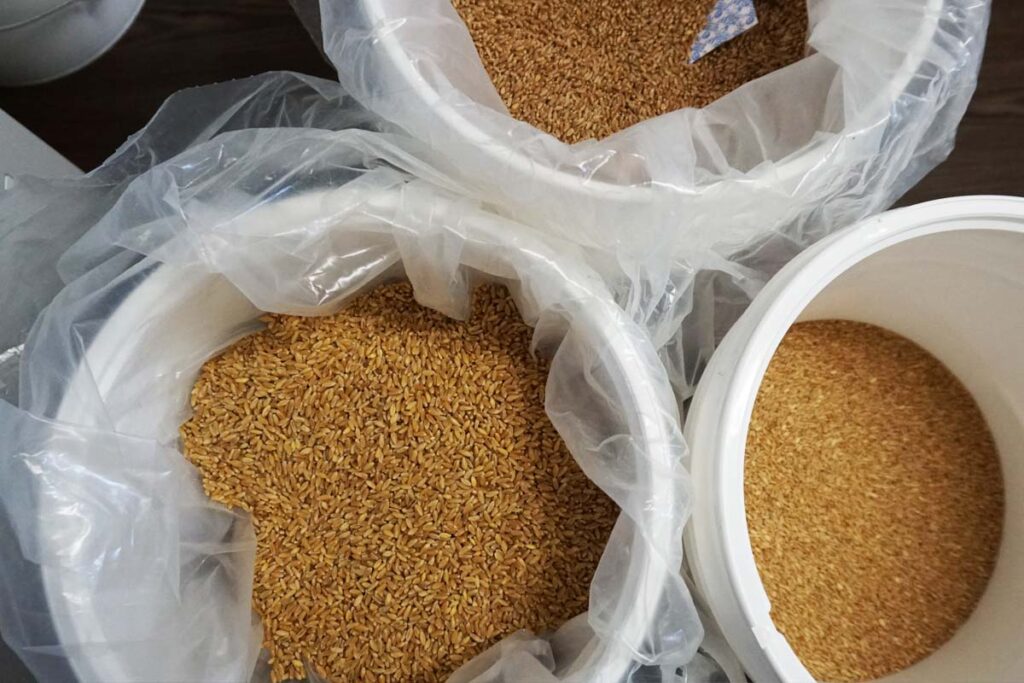Storing whole grains at home can be a challenge, but I’ve found that using food-grade buckets is an excellent solution. These sturdy containers provide an airtight seal, which keeps grains fresh and safe from moisture, pests, and other contaminants. In this article, I’ll share some tips and tricks that I’ve learned over time to help you successfully use food-grade buckets to store your whole grains.
Before diving into the specifics, it’s essential to understand the advantages of using food grade buckets for grain storage. Not only do they protect the grains from external factors, but they also help to preserve the nutritional value of the grains. Additionally, when stored properly, whole grains can have an extended shelf life, making this an economical and environmentally friendly storage option.
To get started, we’ll explore how to choose the right food-grade buckets, prepare the grains for storage, and maintain them so that you can enjoy fresh and delicious whole grains all year round.
Why store whole grains
Storing whole grains properly is essential for maintaining their nutrition, freshness, and overall quality. Not only that, but whole grains can also come in handy as survival food during times of food shortage or emergencies.
One reason I store whole grains is for their nutritional benefits. They are packed with vitamins, minerals, and dietary fiber which can help improve digestion and overall health. As part of a balanced diet, whole grains can also contribute to reducing the risk of chronic diseases such as heart disease and diabetes.
Another reason I like to store whole grains is to maintain their freshness. When these grains are exposed to air, moisture, or heat, their quality can quickly deteriorate. This can lead to unpleasant taste or loss of nutrients. By using food-grade buckets for storage, I can keep the grains fresh for a longer period by protecting them from external factors, ensuring I always have the best quality grains to prepare delicious and healthy meals.
Moreover, whole grains can also make great survival food. In situations like natural disasters or food shortages, having a stockpile of whole grains can provide a much-needed source of nutrition and energy. Since they have a relatively long shelf life, especially when stored properly, I feel reassured knowing that I have a reliable food source in times of need.
Global food shortages can be a real threat, and being prepared by having a diverse storage of food items can make a huge difference. By storing whole grains in food-grade buckets, I am creating a future-proof pantry, ready to support me and my family during unpredictable times.
Types of whole grains to store
When it comes to storing whole grains, it’s important to know the different types that are available. In this section, I’ll discuss two main categories of whole grains: soft grains and hard grains.
Soft Grains
Soft grains are generally easier to digest and cook more quickly than hard grains. These grains are ideal for making porridge, cereal, and baked goods. Some of the soft grains that can be stored in food-grade buckets include:
- Oats: Oats are a versatile, nutritious, and gluten-free option that can be used for breakfast, baking, and even skincare.
- Rice: Rice is a staple food in many cultures and comes in several varieties like brown, white, and wild rice. Storing uncooked rice in food-grade buckets can ensure a long shelf life.
- Barley: This nutritious grain is usually found in soups, stews, and even as a base for making some malted drinks.
- Millet: Millet is a gluten-free grain that is commonly used as a substitute for rice or quinoa and can be cooked in a variety of ways.
Hard grains
Hard grains are denser and have a longer cooking time compared to soft grains. They are typically more shelf-stable, making them great options for long-term storage. Some hard grains to store in food-grade buckets include:
- Wheat: Wheat, including varieties like spelt and kamut, are popular grains for bread-making and can be ground into flour or used in whole form
- Corn: Corn is a versatile grain that can be used for cornmeal, grits, and even popcorn. Storing whole corn kernels in food-grade buckets is an excellent way to preserve their freshness
- Rye: Rye is a hearty grain that can be used for bread and other baked goods, or even added to soups and stews for added texture
- Quinoa: This nutrient-packed grain is a complete protein and cooks similarly to rice. It is also an excellent gluten-free option
- Buckwheat: A naturally gluten-free pseudo-grain, buckwheat is typically used in pancakes, crepes, and can even be found as pasta
Other grains that can be stored in food-grade buckets include sorghum, flax, triticale, and even some ancient grains like amaranth. Food-grade buckets help ensure that these grains remain fresh and ready to use when needed.
Selecting food-grade buckets
When I started looking into long-term food storage, I realized the importance of using food-grade buckets for storing whole grains. The heavy-duty plastic helps to keep out pests, light, moisture, and oxygen, making it an excellent choice for preserving food quality.
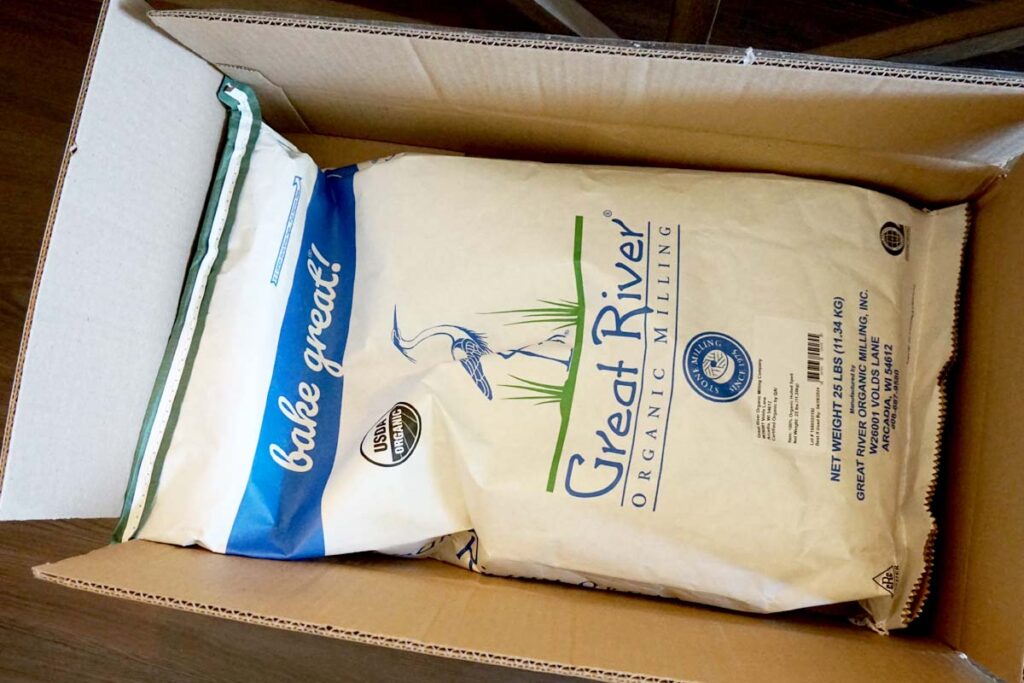
Always ensure the bucket is made of high-density polyethylene (HDPE), which is a material approved by the Food and Drug Administration (FDA) for food storage. To verify the bucket is made of HDPE, I flip it upside down and check for a triangle with the number two inside it at the bottom. Most food-grade buckets are white, so that’s another clue to look for.
After confirming the material, I double-check that the bucket is indeed food grade. Sometimes, recycling number 2 in the triangle does not guarantee it’s suitable for food storage. Make sure to look for any additional labeling or certification that ensures it’s safe for food use.
Size is another important factor to consider. Based on my storage space and the amount of whole grains I plan to store, I choose an appropriate bucket size. Typically, 3.5-gallon, 5-gallon, and 6-gallon buckets are popular choices for storing whole grains.
Once I have my food-grade buckets, I consider the storage method. Some prefer to place whole grains directly into the buckets, while others prefer using polyethylene or mylar bags for an extra layer of protection. I have a big mix of what I use, as it depends on where I buy the grains and what I have on-hand. If I had to choose I’d go with mylar bags as a liner inside the bucket, as they create a barrier against oxygen and pests.
Prepping the buckets and grains
Before storing whole grains in food-grade buckets, I always make sure to clean them thoroughly. A clean, dry, and cool environment helps prevent any issues, such as insects or rodents, from finding their way into our food supply. Checking the seals on the buckets is essential, as these will ensure airtight storage and keep out unwanted guests like dust and insects.
In order to get rid of any potential insect or insect infestation, you can freeze my grains in deep-freeze temperatures for a week before storing them in the buckets. This process will kill any bugs, their eggs, or larvae that may already be in the grains and prevent weevils from contaminating the stored food.
Another helpful tip is to add food-safe desiccant packets, which will absorb any excess moisture in the bucket and maintain the freshness of the grains. This extra bit of protection helps keep the grains crisp and free of mold.
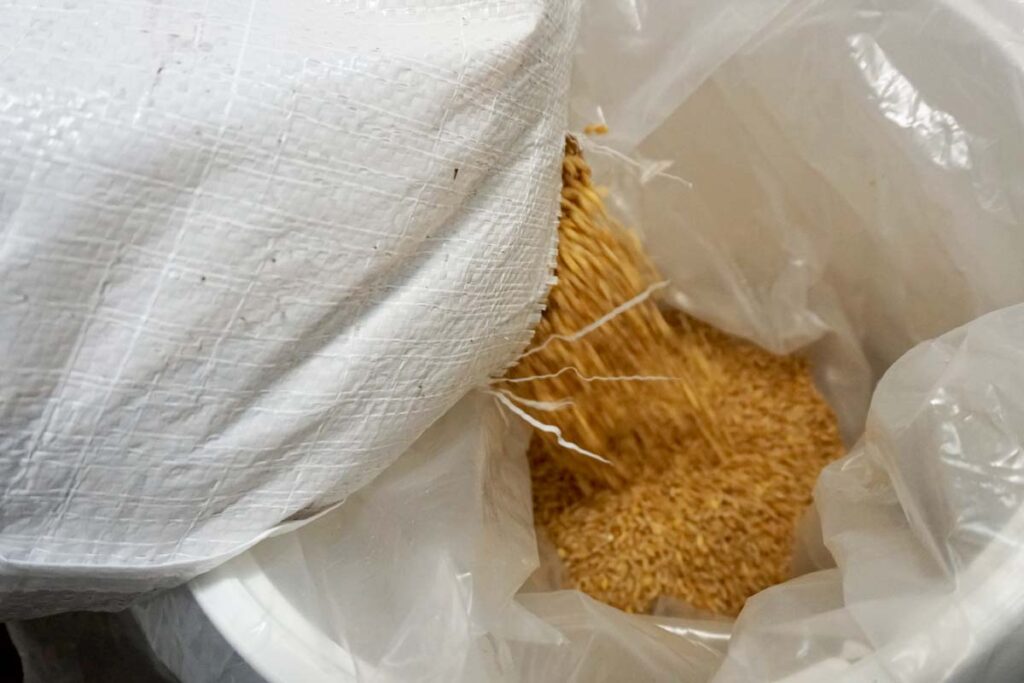
After the grains have been prepped and the buckets are clean, I carefully pour the grains into the buckets, leaving a little bit of room at the top so I can add oxygen absorbers before sealing. Oxygen absorbers are an excellent way to extend the shelf life of whole grains because they remove oxygen from the bucket, reducing the chances of insect infestation and spoilage.
Finally, it’s essential to label the buckets with the contents and the date it was packed. This way, I can keep track of what I’ve stored and rotate the stock, ensuring I’m always using the freshest grains.
By following these steps and using food-grade buckets, I have been able to store whole grains successfully, keeping them fresh and safely away from insects, rodents, and dust.
Storing grains in food-grade buckets
Using oxygen absorbers
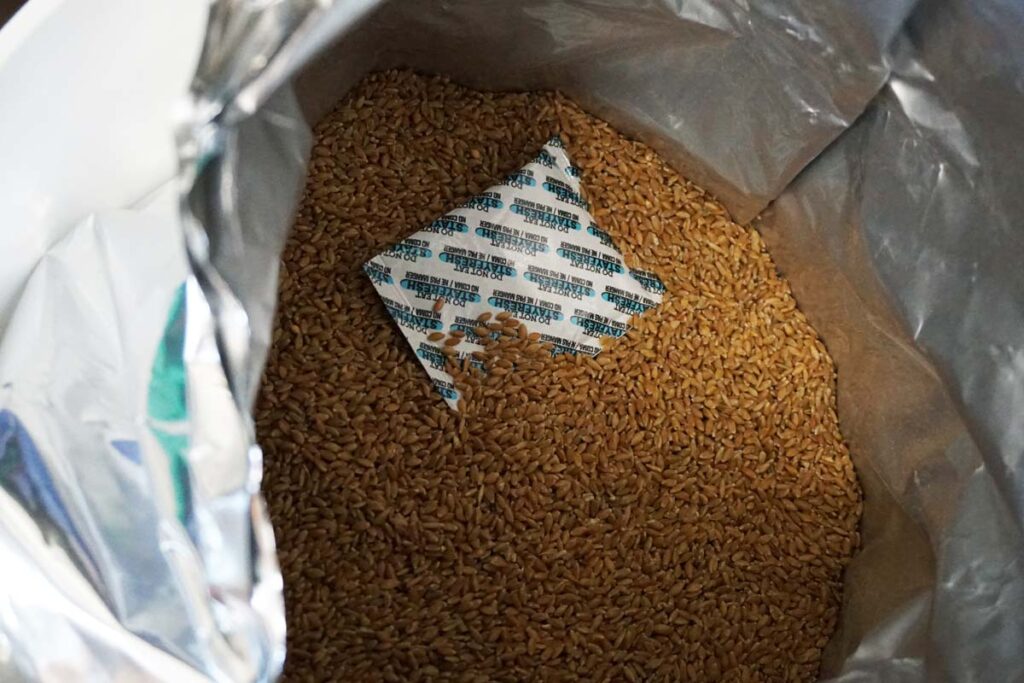
I’ve found that using oxygen absorbers is a key component in storing whole grains in food-grade buckets. Oxygen absorbers work by removing the oxygen from airtight containers, thus preventing the growth of mold, pests, and oxidation. To start, I place an oxygen absorber at the bottom of my airtight food-grade bucket. Then, I add the whole grains, and finally, place another oxygen absorber on top. This ensures that the atmosphere in the bucket remains oxygen-free, extending the shelf life of my grains.
Keep in mind that once you’ve opened the package of oxygen absorbers, it’s important to use them immediately as they begin to absorb oxygen from the moment they’re exposed to air.
Keep this in mind if you’re buying a multi-pack of oxygen absorbers. If it comes in one bag of 10, you want to have 10 buckets ready to go BEFORE you open your oxygen absorbers. Otherwise they will not be any good.
Using mylar bags

Mylar bags provide an extra layer of protection from light, moisture, and pests while maintaining an airtight environment.
To store whole grains in a mylar bag, simply follow these steps:
- Fill the Mylar bag with the desired amount of grains.
- Add an appropriate-sized oxygen absorber to the bag.
- Press out excess air and carefully seal the bag using a heat sealer or a regular household iron.
- Once sealed, place the Mylar bag inside your food-grade bucket for additional protection.
For an added layer of protection, you may want to consider using a vacuum sealer to remove as much air as possible before sealing your mylar bag. This vacuum sealing process helps reduce oxygen exposure and further prolongs the shelf life of your whole grains.
By diligently utilizing food-grade buckets, oxygen absorbers, and mylar bags, I’ve seen significant improvements in the freshness and longevity of my stored whole grains. Just remember, it’s also essential to store your buckets in a cool, dark, and dry place to ensure the best possible results.
Preserving grain quality
One of the most significant aspects of preserving grain quality is controlling moisture and temperature. The ideal environment for whole grain storage is in a cool, dry place as high temperatures and humidity can speed up oxidation and compromise the nutritional value of the grains. I’ve found that maintaining temperatures below 60°F (15°C) with a humidity level less than 15% is an excellent recipe for a longer shelf life.
When storing grains, especially in food-grade buckets, it is important to make sure the container is properly sealed. If it isn’t, oxidation and spoilage can quickly set in, and my precious whole grains could end up being wasted. Therefore, I use containers with airtight lids, called gamma lids, and vacuum seal technology to keep the oxygen out.
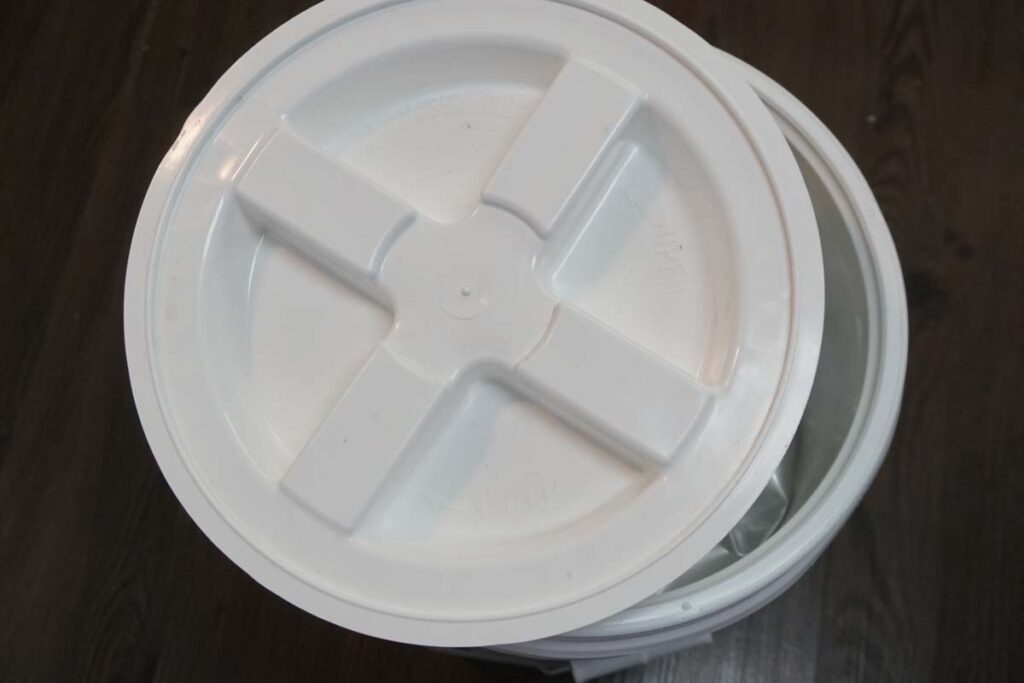
In addition to temperature and moisture control, I also like to take some extra steps to protect the grains and retain their full nutritional value. One excellent method is to use oxygen absorbers, which can significantly reduce the chance of oxidation. By placing one or two oxygen-absorbing packs in the food-grade bucket, I further extend the shelf life of my whole grains.
Another thing I consider when storing whole grains in food-grade buckets is cleanliness. I always ensure that both the grains and the containers are thoroughly clean before sealing them. This reduces the likelihood of any unwanted pests or bacteria contaminating my food supply.
While most whole grains have a naturally long shelf life, whole grain flours tend to lose their nutrients more quickly. That’s why I grind the whole grains into flour when needed, rather than storing large quantities of readymade flour. This way, I can enjoy the full nutritional benefits that my whole grains have to offer.
To sum up, when storing whole grains in food-grade buckets, I make sure to control moisture and temperature, use airtight containers, add oxygen absorbers, keep everything clean, and grind my own whole grain flours. This way, I can enjoy delicious and nutritious whole grains for years to come!
Long-term storage tips
I found a few tips that can help us store whole grains using food-grade buckets for long-term storage.
First, it’s important to choose a moisture-proof, food-grade packaging, such as Mylar-type bags, polyethylene bags, or even plastic buckets. These will help protect our grains from moisture and pests. Make sure to clean the buckets with warm soap and water, and let them dry out completely before storing any food.
Next, consider using oxygen absorbers or dry ice to remove residual oxygen from the grain storage container. This will help prevent the growth of insects and bacteria, and ultimately extend the shelf life.
Finding the right location for the storage is crucial too. It’s best to store the buckets in a cool and dry place, such as a basement, a concrete floor in a garage, or a weatherproof shed. AVOID storing them directly on the ground, and try to keep the buckets a few inches off the floor. This will help maintain the container at the same temperature as the room. Some people recommend not stacking the buckets more than three high, as five gallons of food can be very heavy and potentially compromise the integrity of the containers.
Remember, temperature plays an important role in long-term storage. Try to ensure that your storage location maintains a constant temperature, ideally below 75°F (24°C), as warmer temperatures can decrease the shelf life of stored grains.
Checking stored grains
I make it a priority to regularly check my stored whole grains to ensure their freshness and to prevent any issues like rodent or insect infestations. Here are some tips that help me maintain the quality of my grains.
- Visually inspect the food-grade buckets for any signs of damage or wear. I pay special attention to the lid seals to ensure they are intact and air-tight. This helps in preserving the nutrients in the grains and keeping them fresh for a longer period
- Look out for signs of rodents or insects around the storage area. Since rodents can chew through plastic bags, it’s essential to store the grains in sturdy containers like Mylar-type bags or food-grade buckets. I make sure to keep the area clean and free of debris, which might attract these pests.
- Examine the contents. If I notice any insects, webs, or other impurities, I discard the affected grains and thoroughly clean the container before refilling it with fresh grains. In case of rodent infestation, I might consider using other methods like traps or repellents to protect my stored grains.
How do you know your grains are safe to eat? If you use your senses, you can easily tell. It’s a combination of looking, smelling, and tasting. If something looks off, don’t eat it. If it smells off, don’t eat it. And of course, if it tastes off, don’t eat it.
But, if it looks, smells, and tastes normal, then it’s probably safe to eat.
Using stored grains
I’ve found that using food-grade buckets is an excellent way to store whole grains for long-term use. It’s something I’ve learned the hard way, when I lost an entire bag of whole grain to pantry months.
It helps to maintain the quality and freshness of the grains, ensuring that they’re ready to be used when needed. Here are some tips:
- Invest in a grain mill. A grain mill allows me to transform the whole grains into flour, making it much easier to incorporate them into my favorite recipes. (If you aren’t familiar with grain mills and need help to find one that works for you, you can check out my buyer’s guide here for Grain Mill 101.)
- Consider freezing your grains first. You can take some extra steps to preserve freshness. One method I use is to freeze the grains for about 48 hours before transferring them to the storage bucket. This helps to eliminate any pests or insects that may be hiding in the grains. After the freezing process, I let them thaw and come back to room temperature for at least 24-hours before sealing the bucket
- Store food-grade buckets with grains in a cool, dark, and dry place, such as a pantry or a dedicated storage room. This helps to prevent any potential damage from heat, moisture, or light exposure.
Where to Buy Whole Grains and Food-Grade Buckets
When it comes to storing whole grains, food-grade buckets are an excellent option. In this section, I’ll share some recommendations for where to buy both whole grains and food-grade buckets, making it easy for you to stock up and store your grains safely.
Bulk Grain Suppliers
Purchasing whole grains in bulk is a great way to save money and ensure you always have a supply on hand. One of my favorite places to buy grains in bulk is Azure Standard. They offer a wide variety of grains, from wheat berries to rice, and they deliver to many locations throughout the United States. Important note: Some of my grains from Azure are phenomenal. I recently got a big order and every grain I bought was perfect. Other times my grains have been so dirty, I am unable to use them in my grain mill. Azure only gives you a short amount of time to notice an error and contact them for a refund/replacement. Keep this in mind when ordering from them.
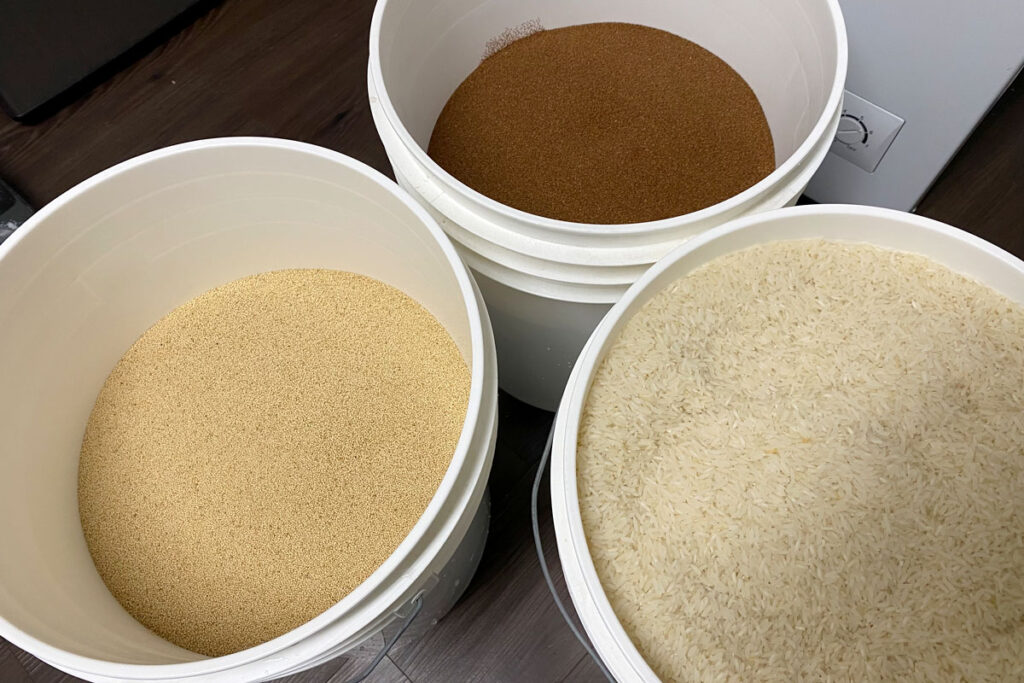
Another option for purchasing bulk grains is Pleasant Hill Grain. They have a large selection of grains available in 10, 25, or 50 pound bags and all of their grains are triple-cleaned. They also come shipped in buckets, so if you’re not ready to use the grain, they will store indefinitely.

Buying grains online can also be as simple as shopping through Amazon.com. While it might not always offer the best prices, the convenience of ordering with just a few clicks and having the products delivered to your doorstep cannot be denied. Important note: Make sure you’re ordering from a reputable brand on Amazon. Also, always check the sellers website as it is not always cheaper on Amazon. Often I find that ordering directly from the manufacturer can be the same price or slightly cheaper. Also, most grains on Amazon are not sold in buckets, but rather, bags.

Food-Grade Bucket Suppliers
Once you have your whole grains, you’ll need food-grade buckets for storage. Look for buckets that are specifically marked as food-grade, as these are designed to keep your grains safe and uncontaminated.
Tractor Supply Co. is a well-known retailer that sells 5-gallon food-grade utility pails. These buckets are perfect for bulk food storage and can be found both in-store and online. Additionally, they often offer excellent customer service and fair prices. I’ve always been able to get gamma lids at my local Tractor Supply as well.
Azure Standard is another place to consider when searching for food-grade buckets. I know that I’m getting true food-grade quality (sometimes ordering from somewhere like Amazon makes me question … where did these buckets really come from?!) and it’s easy to add onto my order if I’m already making a bulk food order from them. Here are the ones I usually order.
By purchasing whole grains from trusted suppliers and using proper food storage techniques with food-grade buckets, you’ll be well on your way to a stocked pantry filled with healthy, whole grains.
Frequently asked questions
What is the ideal storage method for whole grains in food-grade buckets?
I have found that the best method for storing whole grains like wheat berries or white rice in food-grade buckets is to first place them in mylar bags and then add oxygen absorbers. This keeps the grains fresh, protected from light and moisture, and extends their shelf life.
How can I protect stored grains from insect infestation?
To prevent insect infestation in stored grains, I usually freeze the grains in their original packaging for at least three days before transferring them to mylar bags or other containers. The freezing process kills live bugs and helps keep insects at bay during storage. I talk about this in depth in my overview of pantry moths.
Which containers should I use for storing wheat at home?
For short-term storage of wheat, I recommend using plastic bags, jars, or large Tupperware-like containers, as they can keep the grains fresh for several months. I typically use a Ziplock bag. For long-term storage, consider using mylar bags and oxygen absorbers inside food-grade buckets.
What factors determine the longevity of wheat in a 5-gallon bucket?
The longevity of stored wheat in a 5-gallon bucket depends on several factors, including proper sealing, temperature, humidity, and light exposure. Following the right storage method, like using airtight Mylar bags and oxygen absorbers, will ensure that the grains stay fresh for as long as possible.
How do I prepare whole grains for long-term storage?
Before placing whole grains into long-term storage, I thoroughly clean them to remove any debris or contaminants. Then, I freeze them for up to 3 days to kill any insects. Afterward, I transfer the grains into mylar bags and add oxygen absorbers before sealing the bags and placing them into food-grade buckets.
Are there any special requirements for storing grains in food-grade buckets?
It is important to use food-grade buckets when storing grains to ensure their safety and prevent contamination from non-food-safe plastics. However, food-grade buckets alone may not provide adequate protection from air, light, and moisture. This is why I always recommend using mylar bags and oxygen absorbers inside the buckets for better grain preservation.

